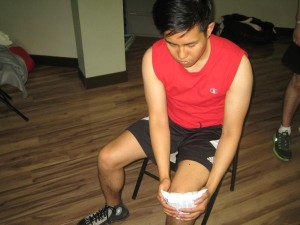The pes anserinus is basically a group of 3 tendons that form at a common point on the side of the knee. In the previous years, it is believed that this tendon group somewhat resembles the 3 webbed toes of a goose. The pes anserinus bursa is the sac filled with fluid that is positioned close to these tendons. The bursa is prone to inflammation and can be considered as a source for the knee pain among those who play sports.
Close look on the anatomy
The 3 muscles whose tendons form the pes anserinus start in the upper thigh. The tendons that are attached to these muscles insert on the interior front aspect of the tibia bone which is 1-2 inch below the actual knee joint.
The pes anserinus bursa is situated between a knee joint ligament and this tendon. The bursa is responsible for mitigating the potential effects of friction amidst the tendon and the joint as the knee extends and flexes.
What are the signs and symptoms?

The pain due to pes anserinus bursitis is usually localized to the location of the bursa. The pain can be a deep, aching quality that typically occurs in a gradual manner that increases over time. This might be noticeable when standing up from a chair. This is rarely worsened by normal walking on a level terrain but can be aggravated by descending or ascending stairs. The symptoms might be more evident while running up and downhills.
What are the possible causes?
Overuse is one reason why this condition develops. Among runners, this might mean an abrupt increase in the intensity of training such as running on stairs or hills. Remember that a sudden increase in the mileage can also be considered as a factor. Hiking over uneven terrain might also be a cause or pushing a lawn mower around a bumpy yard.
Some individuals might be predisposed anatomically to end up with pes anserinus bursitis. In one study that was conducted, individuals who have an excessive valgus angle at the knee or commonly called as “knock-kneed” face the highest risk for developing pes anserinus bursitis.
Diagnosis
A diagnosis is typically based on the description of the pain and the location. In most cases, there is tenderness when direct pressure is applied over the bursa. Oftentimes, swelling is also evident.
An X-ray is rarely beneficial in determining a diagnosis but performed in order to rule out a stress fracture that can cause similar symptoms. An MRI of the affected knee can reveal the distinctive results of fluid swelling under the tendons of the pes anserinus.
Management and preventive measures
The primary treatment options are focused on reducing the inflammation due to the pes anserinus bursitis. Adequate rest and application of an ice pack are highly beneficial. At the start, non-steroidal anti-inflammatory drugs (NSAIDs) are also recommended.
In some circumstances, cortisone injections are also administered to reduce the degree of inflammation. The later measures might focus on stretching of the hamstrings as well as strengthening of the quadriceps with the objective of gradually returning to normal activities without triggering the recurrence of the condition.
